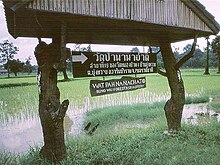Wat Pah Nanachat
| Wat Pah Nanachat Buddhist Monastery | |
|---|---|

Pointing the way along the path to Wat Pa Nanachat
|
|
| Basic information | |
| Location |
Wat Pah Nanachat Bah Bung Wai, Ampher Warin Chamrab, Ubon Ratchathani 34310, THAILAND |
| Affiliation | Thai Forest Tradition |
| Country | Thailand |
| Website | http://www.watpahnanachat.org |
| Founder | Luang Por Ajahn Chah |
Wat Pah Nanachat Bah Bung Wai, Ampher Warin Chamrab, Ubon Ratchathani 34310,
Wat Pah Nanachat (Thai: วัดป่านานาชาติ, International Forest Monastery) is situated in a small forest in northeast Thailand about 15 kilometres from the city of Ubon Rachathani. It is an international forest monastery primarily for non-Thais. The late Ajahn Chah established the monastery in 1975 to serve as a training community for non-Thais along traditional monastic lines. Its monks, novices and postulants include a wide range of nationalities. The primary language of communication and instruction is English.
The monastery was founded in response to increasing international interest, particularly from the United Kingdom, in the theravadin forest tradition of Thailand. The first abbot of Wat Pah Nanachat was Ajahn Sumedho, an American bhikkhu trained by Ajahn Chah at Wat Nong Pah Pong, the mother house of Wat Pah Nanachat. Today, as a consequence, students of the Thai forest tradition are found in branch monasteries around the world under the collective label of The Forest Sangha. The largest monastery of this network is Amaravati Monastery, about 30 miles north of London. Its abbot was Ajahn Sumedho, who recently relinquished the post to Ajahn Amaro (ex-co-abbot of Abhayagiri Buddhist Monastery in California).
Buddhist meditation practice of all types is encouraged at Wat Pananachat, though breathing meditation predominates. In the spirit of Ajahn Chah's teachings, vipassanā, or insight, and samatha, or concentration, are regarded as two sides of a coin rather than two distinct categories. Lay visitors are expected to observe the eight precepts version of sila, or the practice of virtue. For monks, strict adherence to the Vinaya, the 2,500-year-old code of discipline, is not only required but is the distinguishing characteristic of the lineage. For lay visitors, no formal meditation teaching is available beyond Dhamma talks and what may be derived from freely available reading matter, the priority being the formal training of the full-time mendicants.
...
Wikipedia
